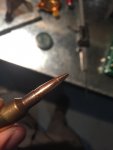So Im brand new to reloading and went ahead and started working up a load for my 6.5x47L rifle. Went through all the steps with the help of the articles here and youtube, and ended up at the bullet seating stage. Now Im using Lapua Brass, Barnes 140gr Matchburner Bullets, Redding Competition Dies (FL and Bullet Seater), Hornady Lock n Load Bushings, and a RCBS Rockchucker Press (Old version).
When I went to seat my bullets I kept getting variations, with the widest spread being as much as 0.01 difference. Went ahead and FL sized all my cases (0 firings)(figured it was worth a shot), and sorted my bullets. This helped bring it down to 0.004-0.005 variations but Im still not happy with that. I resorted to backing out and slowly adjusting for every single round, which got me the seating depth I wanted in order to head to the range but feel that something must be up that I need to fix. Not to mention it took forever to do.
Ive sorted bullets, adjusted the die to have very small gap between ram and die, cleaned out the die, made sure I was using equal force on ram, Double checked neck tension, and still get the swings. Any help would be greatly appreciated!
Also, the die appears to be marking the bullets and it feels almost as if I have to pull the bullet out of the stem once seated. Not a ton of force but it certainly does need a tap to pop it free.
And one last thing, what is the acceptable amount of variation for field/comp use?
Thanks!
When I went to seat my bullets I kept getting variations, with the widest spread being as much as 0.01 difference. Went ahead and FL sized all my cases (0 firings)(figured it was worth a shot), and sorted my bullets. This helped bring it down to 0.004-0.005 variations but Im still not happy with that. I resorted to backing out and slowly adjusting for every single round, which got me the seating depth I wanted in order to head to the range but feel that something must be up that I need to fix. Not to mention it took forever to do.
Ive sorted bullets, adjusted the die to have very small gap between ram and die, cleaned out the die, made sure I was using equal force on ram, Double checked neck tension, and still get the swings. Any help would be greatly appreciated!
Also, the die appears to be marking the bullets and it feels almost as if I have to pull the bullet out of the stem once seated. Not a ton of force but it certainly does need a tap to pop it free.
And one last thing, what is the acceptable amount of variation for field/comp use?
Thanks!
Last edited:


